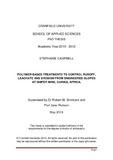JavaScript is disabled for your browser. Some features of this site may not work without it.
| dc.contributor.advisor | Simmons, Robert W. | |
| dc.contributor.advisor | Rickson, R. Jane | |
| dc.contributor.author | Campbell, Stephanie | |
| dc.date.accessioned | 2014-02-10T11:15:06Z | |
| dc.date.available | 2014-02-10T11:15:06Z | |
| dc.date.issued | 2013-05 | |
| dc.identifier.uri | http://dspace.lib.cranfield.ac.uk/handle/1826/8259 | |
| dc.description.abstract | It is necessary to understand the erodibility and hydrological response of mine-site slope forming materials (SFMs), because of increasing awareness of the environmental impacts of mining. Steep engineered slopes in high intensity rainfall environments present a serious erosion risk. Temporary surface stabilisers, such as polyacrylamides (PAMs) and polyvinylacrylic latex (PVALs) are potentially cost effective erosion control solutions. In this study PAM and PVAL efficacy to reduce runoff, leachate and erosion was assessed at two application rates, with and without gypsum on SFMs from an iron ore mine in Guinea (West Africa). NSPASS (near-surface photogrammetry assessment of slope forming materials’ surface roughness) is a novel method that integrates digital image capture and GIS. It is shown to detect and quantify surface micro-relief changes of 2-3 mm, not visible to the naked eye. As expected, soil and non-soil SFMs were significantly different in terms of their physical and chemical properties. Phase I of the study investigated the erodibility of ten SFMs, including soil, ore and waste-rock. The results indicate that the hydrological response to rainfall of most SFMs is to generate leachate. Weathered phyllite (PHY-WEA) is the most erodible SFM by both runoff and leachate. Multiple regression analysis demonstrated that magnetic susceptibility, mineralogy and dry aggregate distribution; parameters not commonly assessed in erosion studies, are important in explaining SFM erodibility and hydrological response. Phase II evaluated critically the effectiveness of three commercially available polymer solutions (two PAMs and one PVAL) at reducing runoff, leachate and erosion from four of the most erodible SFMs identified in Phase I. The results indicate that some PAM and PVAL treatments significantly reduce runoff, leachate and erosion. Polymer efficacy is highly dependent on the physical and chemical properties of the SFM, as well as the mechanism of polymer to SFM adsorption. Increasing the application rate of select treatments lowered leachate volumes, runoff and leachate total sediment loads. Contrary to previous studies, gypsum amendments did not significantly improve polymer efficiency. This research has added to our understanding of the erodibility and hydrological response of soil and non-soil SFMs. This is the first study to evaluate critically the efficacy of PVALs in controlling erosion from mine-site SFMs. Future studies should continue to optimise NSPASS performance in monitoring changes in surface micro-relief. | en_UK |
| dc.language.iso | en | en_UK |
| dc.publisher | Cranfield University | en_UK |
| dc.rights | © Cranfield University 2013. All rights reserved. No part of this publication may be reproduced without the written permission of the copyright owner. | en_UK |
| dc.subject | Slope forming materials (SFMs) | en_UK |
| dc.subject | erodibility | en_UK |
| dc.subject | hydrological response | en_UK |
| dc.subject | polymer-based treatments (PBTs) | en_UK |
| dc.subject | polyacrylamide (PAM) | en_UK |
| dc.subject | polyvinylacrylic latex (PVAL) | en_UK |
| dc.title | Polymer-based treatments to control runoff, leachate and erosion from engineered slopes at Simfer Mine, Guinea, Africa | en_UK |
| dc.type | Thesis or dissertation | en_UK |
| dc.type.qualificationlevel | Doctoral | en_UK |
| dc.type.qualificationname | PhD | en_UK |
